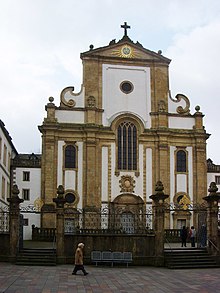Market Church (Paderborn)
The former Jesuit and university church , Sankt Franz Xaver , also called " Marktkirche ", is located in the center of Paderborn , near the town hall square and right next to the Theodorianum grammar school , which uses the church for Catholic school services on Thursdays. In addition, the market church is next to the Gau Church of St. Ulrich and the Busdorf Church "Sankt Petrus und Andreas" parish church of the Paderborn inner city parish "Sankt Liborius", founded in 1998.
It got its name “Market Church” when the original market church “Sankt Pankratius” at today's Marienplatz had to be demolished in 1784 due to dilapidation and it then took over the function of the parish church for the previous market church parish.
The foundation stone of today's market church was laid in 1682 by Prince-Bishop Ferdinand von Fürstenberg . The plans for the three-aisled baroque gallery basilica come from the Jesuit lay brother Anton Hülse . After only ten years of construction, it was consecrated as a Jesuit church on September 14, 1692 . Even when it was founded, the church was a university and high school church.
Building design
A first series of plans by Antonio Petrini from Würzburg , created in 1681, already envisaged a gallery basilica, albeit in classical forms with floor-to-ceiling pilasters and baroque vaults, but without the choir delimitation. Instead of this plan, which was seen as too expensive, Anton Hülse presented a new plan in 1682, which was also the basis for the execution from 1683–86. As in the two Jesuit churches in Münster and Cologne , Hülse used continuous round pillars and above all Gothic ribbed vaults. The two-storey facade is strongly structured by pliaster templates and glare fields and closed with a triangular gable, the Gothic tracery window emphasized by the round-arched cornice. In its post-Gothic design, the Paderborn Jesuit Church exerted a significant influence on the further construction of the Weser Baroque church .
Baroque altar
During the Second World War , the baroque altar was completely destroyed in March 1945. Through initiative and a. of the former headmaster of the Theodorianum Franz Josef Weber and the initiator Georg Hagenhoff, 1st chairman of the Heimatverein Paderborn eV , the Förderverein Barockaltar der Marktkirche eV was founded in March 1985 by the Heimatverein Paderborn eV and Franz Josef Weber was appointed 1st chairman after February a reconstruction by the state curator Dietrich Ellger in a lecture in the savings box of the Sparkasse Paderborn was considered possible. Together with the city of Paderborn and the state of North Rhine-Westphalia , the costs were divided into three.
The complete reconstruction was carried out in eight construction phases using photos and templates.
In the first two construction phases (1989–1990 and 1990–1993) the “large-scale architecture” was restored for approx. 1.8 million DM. H. the three floors of the 20.75 m high, 10.20 m wide and 4 m deep altar, including the twelve twisted columns, which, however, remained smooth and white in this phase. A handle vase and a 1.7 m high and four hundred pound Jesuit coat of arms with the well-known initials IHS were attached.
In the 3rd to 5th construction phase (1993–1994, 1995 and 1996–1997), the ornamentation , the floral decoration and the putti were restored for approx. 2.7 million DM with the help of renowned sculptors .
In the 6th and 7th construction phase (1998–2000 and 2000–2001) the rest of the work on the floral decoration was completed, the four evangelist figures were created on the second floor and the gilding began. The costs for this amounted to approx. DM 2.2 million.
In the 8th and final construction phase (2002–2004) the gilding and coloring was completed for approx. 1.3 million DM. A total of 8 million DM (approx. 4 million euros) went into the reconstruction in the 15 years of construction.
organ
For the former church of the Jesuit College, Prince-Bishop Dietrich von Fürstenberg donated a new organ with 12 registers from 1616 to 1618, which was initially taken over in the new church. It was not until 1730 that a new organ case was built, which, divided into two parts, was set up on the side of the large facade window and thus performed an important spatial design function. In 1735–36 the work was installed around 800 Reichstaler, probably by Johann Patroclus Möller from Lippstadt , using the registers of the older organ. In 1874–76, Carl August Randebrock from Paderborn built a new plant in the old case, and in 1963–64 the organ destroyed in 1945 was replaced by a new one. A reconstruction of the baroque organ front was not carried out, although together with the high altar it had made a decisive contribution to the spatial effect of the church.
Disposition before 1690:
|
|||||||||||||||||||||||||||||||||||||||
Disposition 1845 (probably original disposition from 1735):
|
|
|
||||||||||||||||||||||||||||||||||||||||||||||||||||||||||||||||||||||||||||||||||||||||||||||||
See also
literature
- Otto Gaul, Anton Henze , Fried Mühlberg , Fritz Stich: Reclam's Art Guide Germany, Bd. 3, North Rhine-Westphalia (art monuments and museums) . Stuttgart 1982.
- Joseph Braun : The church buildings of the German Jesuits. A contribution to the cultural and art history of the 17th and 18th centuries. tape 1 , 1908, 11. The Church of St. Franz Xaver zu Paderborn ( digitized version ).
References and comments
- ↑ Liborius Parish Paderborn
- ^ Karl Josef Schmitz: Basics and beginnings of baroque church architecture in Westphalia . Association for the History and Archeology of Westphalia, Paderborn 1969, pp. 56–67.
- ^ Rudolf Reuter : Organs in Westphalia. Bärenreiter, Kassel 1965, pp. 209–211.
Web links
Coordinates: 51 ° 42 ′ 58 " N , 8 ° 45 ′ 13.3" E


